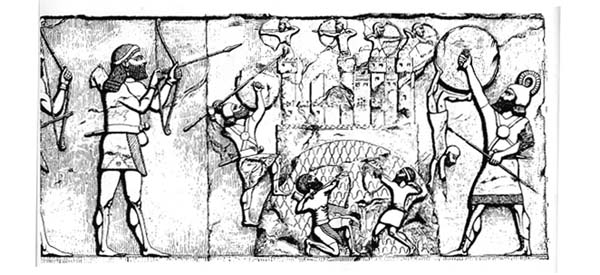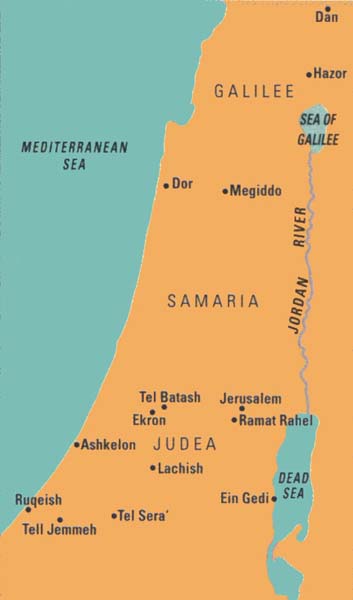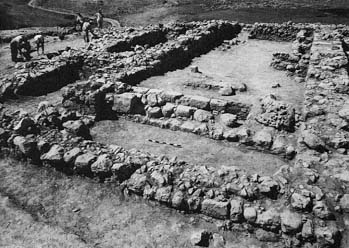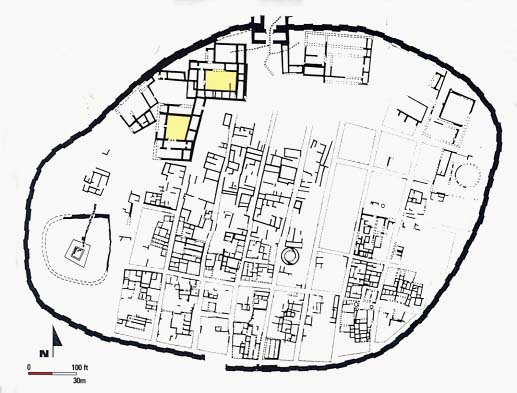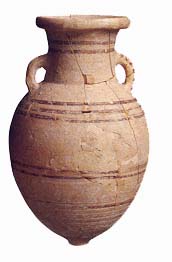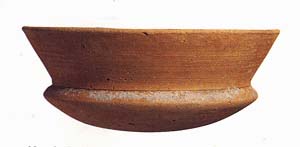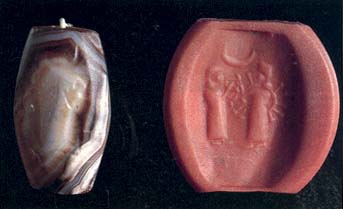The Babylonian Gap
The Assyrians impressed their culture on Israel … the Babylonians left no trace
Footnotes
See Hershel Shanks, “Excavating in the Shadow of the Temple Mount,” BAR 12:06; Benjamin Mazar, “Excavations Near Temple Mount Reveal Splendors of Herodian Jerusalem,” BAR 06:04; Suzanne F. Singer, “Found in Jerusalem: Remains of the Babylonian Siege,” BAR 02:01; Nitza Rosovsky, “A Thousand Years of History in Jerusalem’s Jewish Quarter,” BAR 18:03.
See Lawrence E. Stager, “The Fury of Babylon,” BAR 22:01.
Endnotes
For an archaeological survey of the period, see Saul S. Weinberg, “Post-Exilic Palestine: An Archaeological Report,” The Israel Academy of Sciences and Humanities Proceedings 4 (1969), pp. 78–97.
On the stratigraphy of all these sites, see Ephraim Stern, ed., The New Encyclopedia of Archaeological Excavations in the Holy Land (NEAEHL), 4 vols. (Jerusalem: Israel Exploration Society, 1993); on the Rishon le-Zion fort, see Samuel R. Wolff, “Archaeology in Israel,” American Journal of Archaeology 100 (1996), p. 744.
P.W. Dajani, “A Neo-Babylonian Seal from Amman,” Annual of the Department of Antiquities of Jordan (ADAJ) 6–7 (1962), pp. 124–125; Stern, The Material Culture of the Land of the Bible in the Persian Period, 538–332 B.C.E. (Warminster, UK: Aris & Phillips, 1982), pp. 196–197, “Assyrian and Babylonian Elements in the Material Culture of Palestine in the Persian Period,” Transeuphratene 7 (1994), pp. 51–62; Tallay Ornan, Observations over the Glyptic Finds in Israel and Jordan: Assyrian, Babylonian and Achaemenian Cylinder-Seals from the First Half of the First Millennium B.C.E., M.A. thesis (Hebrew), (Jerusalem: Hebrew University, 1990); Nahman Avigad and Benjamin Sass, Corpus of West Semitic Stamp Seals (Jerusalem: Israel Academy of Sciences and Humanities, Israel Exploration Society and the Institute of Archaeology, Hebrew University, 1997).
Stern, NEAEHL, vol. 3, p. 1044; Stephanie M. Dalley, “The Cuneiform Tablet from Tawilan,” in Crystal M. Bennet and Piotr Bienkowski, Excavations at Tawilan in Southern Jordan (Oxford: Oxford Univ. Press, 1995), pp. 67–68.
Dalley and A. Goguel, “The Sela’ Sculpture: A Neo-Babylonian Rock Relief in Southern Jordan,” ADAJ 41 (1997), p. 169.
John W. Crowfoot, Grace M. Crowfoot and Kathleen M. Kenyon, Samaria-Sebaste III: The Objects (London: Palestine Exploration Fund, 1957), p. 35, pl. 4: 2–3; Zdzislaw J. Kapera, “The Ashdod Stele of Sargon II,” Folia Orientalia 17 (1976), pp. 87–99; Yosef Porath et al., The History and Archaeology of Emek Hefer (Tel Aviv: ha-Kibuts ha-me’uhad, 1985), no. 3, p. 58.
Robert Alexander Stewart Macalister, The Excavations of Gezer, vol. 1 (London: J. Murray, 1912), pp. 22–29; Bob Becking, “The Two Neo-Assyrian Documents from Gezer in their Historical Context,” Jahrbericht Ex Orient Lux 27 (1983), pp. 76–89; Ronny Reich and Bosnat Brandl, “Gezer under Assyrian Rule,” Palestine Exploration Quarterly 117 (1985), pp. 41–54; Veysel Donbaz, “Gezer’s Third Cuneiform Tablet,” State Archives of Assyria Bulletin, 11:1 (1988), p. 6, no. 13; Marcel Sigrist, “Une Tablette Cuneiforme de Tell Keisan,” Israel Exploration Journal (IEJ) 32 (1982), pp. 32–35, Samaria Harvard, vol. 2, p. 247, no. 1, pl. 56; Mordechai Cogan, “A Lamashtu Plaque from Judean Shephela,” IEJ 45 (1995), pp. 155–161; Nadav Na’aman, “The Assyrian Deportations to Palestine: Culture and Historical Aspects,” Proceedings of the 22 Archaeological Conference in Israel (Tel Aviv: Israel Exploration Society, 1996), p. 12 (Hebrew); Gary Beckman, “Tablet Fragments from Sepphoris,” Nouvelles Assyriologiques Brêves et Utilitaires (1997), no. 3, pp. 81–82.
Ruth Amiran and Immanuel Dunayevski, “The Assyrian Open-Court Building and Its Palestinian Derivatives,” Bulletin of the American Schools of Oriental Research 149 (1958), pp. 25–32; Volkmar Fritz, “Die Palaste wahrend der assyrischen, babylonischen und persischen Vorherrschaft in Palastina,” Mitteilungen der deutschen Orient-Gesellschaft 111 (1979), pp. 63–74; Reich, “Assyrian Royal Buildings in the Land of Israel,” in Hannah Katzenstein et al., eds., The Architecture of Ancient Israel (Jerusalem: Israel Exploration Society, 1992), pp. 214–222.
Jeffrey R. Zorn, “Mesopotamian Style Ceramic ‘Bathtub’ Coffins from Tell En-Nasbeh,” Tel Aviv 20 (1993), pp. 216–224, “More on Mesopotamian Burial Practices in Ancient Israel,” IEJ 47 (1997), pp. 214–219; David Ussishkin and John Woodhead, “Excavations at Tel Jezreel, 1994–1996, Third Report,” Tel Aviv 29 (1997), pp. 33–40.
Amiran, “A Late Assyrian Stone Bowl from Tel el-Qitaf in the Beth Shean Valley,” ‘Atiqot (English Series) 2 (1959), pp. 129–132; Ruth Hestrin and Stern, “Two ‘Assyrian’ Bowls from Israel,” IEJ 23 (1973), pp. 152–155; Ayelet Gilboa, “Assyrian Type Pottery at Dor and the Status of the Town During the Assyrian Occupation Period,” Eretz Israel 25 (1996), pp. 16–121 (Hebrew).
Abraham J. Sachs, “Late Assyrian Royal Seal Type,” Iraq 15 (1953), pp. 167–170; Alan R. Millard, “Royal Seal Type Again,” Iraq 27 (1965), pp. 12–16; Ornan, “A Mesopotamian Influence on West Semitic Inscribed Seals” in Sass and Christoph Uehlinger, eds., Studies in the Iconography of Northwest Semitic Inscribed Seals, Orbis biblicus et orientalis 25 (Frieburg: Universitatsverlag, 1993), pp. 52–73; Stern, “Notes on the Development of Stamp-Glyptic Art in Palestine During the Assyrian and Persian Periods,” in Lewis M. Hopfe, ed., Uncovering Ancient Stones: Essays in Memory of H.N. Richardson (Winona Lake, IN: Eisenbrauns, 1994), pp. 135–146; Haim Tadmor and Miriam Tadmor, “The Seal of Bel-Ashardu—A Case of Migration,” in Karel van Lerberghe and Antoon Schoors, eds., Immigration and Emigration within the Ancient Near-East: Festschrift E. Lipinski(Leuven: Uitgeverij Peeters en Departement Orientalistiek, 1995), pp. 345–355.
William F. Albright, “Notes on Ammonite History,” in Lawrence T. Geraty and Larry G. Herr, eds., The Archaeology of Jordan and Other Studies: Presented to Siegfrid H. Horn (Berrien Springs, MI: Andrews Univ. Press, 1986), pp. 503–509; George M. Landes, “The Material Civilization of the Ammonites,” Biblical Archaeologist 24 (1961), pp. 66–86; Herr, “What Ever Happened to the Ammonites?” BAR 19:06, “The Late Iron Age-Persian Ceramic Horizon at Tall al ‘Umayri,” Studies in the History and Archaeology of Jordan, vol. 5 (Amman: Department of Antiquities, 1995), pp. 617–619.

